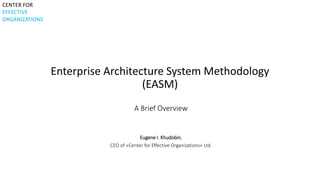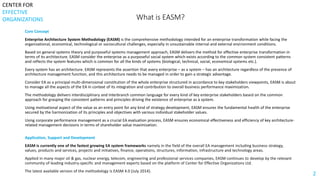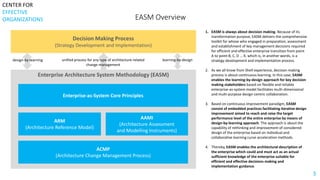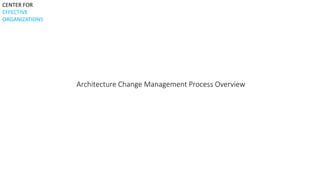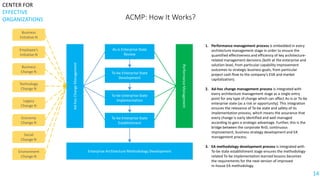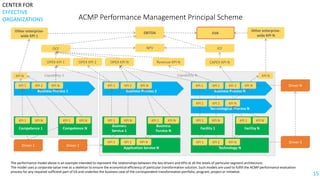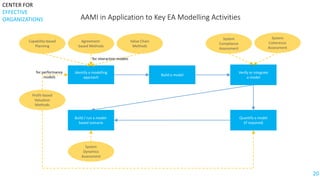EASM. A Brief Overview
- 1. Enterprise Architecture System Methodology (EASM) A Brief Overview Eugene I. Khudobin, CEO of «Center for Effective Organizations» Ltd. CENTER FOR EFFECTIVE ORGANIZATIONS
- 2. What is EASM? CENTER FOR EFFECTIVE ORGANIZATIONS 2 Core Concept Enterprise Architecture System Methodology (EASM) is the comprehensive methodology intended for an enterprise transformation while facing the organizational, economical, technological or sociocultural challenges, especially in unsustainable internal and external environment conditions. Based on general systems theory and purposeful systems management approach, EASM delivers the method for effective enterprise transformation in terms of its architecture. EASM consider the enterprise as a purposeful social system which exists according to the common system consistent patterns and reflects the system features which is common for all the kinds of systems (biological, technical, social, economical systems etc.). Every system has an architecture. EASM represents the assertion that every enterprise – as a system – has an architecture regardless of the presence of architecture management function, and this architecture needs to be managed in order to gain a strategic advantage. Consider EA as a principal multi-dimensional constitution of the whole enterprise structured in accordance to key stakeholders viewpoints, EASM is about to manage all the aspects of the EA in context of its integration and contribution to overall business performance maximization. The methodology delivers interdisciplinary and interbranch common language for every kind of key enterprise stakeholders based on the common approach for grasping the consistent patterns and principles driving the existence of enterprise as a system. Using motivational aspect of the value as an entry point for any kind of strategy development, EASM ensures the fundamental health of the enterprise secured by the harmonization of its principles and objectives with various individual stakeholder values. Using corporate performance management as a crucial EA evaluation process, EASM ensures economical effectiveness and efficiency of key architecture-related management decisions in terms of shareholder value maximization. Application, Support and Development EASM is currently one of the fastest growing EA system frameworks namely in the field of the overall EA management including business strategy, values, products and services, projects and initiatives, finance, operations, structures, information, infrastructure and technology areas. Applied in many major oil & gas, nuclear energy, telecom, engineering and professional services companies, EASM continues to develop by the relevant community of leading industry-specific and management experts based on the platform of Center for Effective Organizations Ltd. The latest available version of the methodology is EASM 4.0 (July 2014).
- 3. EASM Overview CENTER FOR EFFECTIVE ORGANIZATIONS Decision Making Process (Strategy Development and Implementation) design-by-learning unified process for any type of architecture-related change management learning-by-design Enterprise Architecture System Methodology (EASM) Enterprise-as-System Core Principles ARM (Architecture Reference Model) ACMP (Architecture Change Management Process) 3 AAMI (Architecture Assessment and Modelling Instruments) 1. EASM is always about decision making. Because of its transformation purpose, EASM delivers the comprehensive toolkit for whose who engaged in preparation, assessment and establishment of key management decisions required for efficient and effective enterprise transition from point A to point B, C, D … X, which is, in another words, is a strategy development and implementation process. 2. As we all know from Shell experience, decision making process is about continuous learning. In this case, EASM enables the learning-by-design approach for key decision making stakeholders based on flexible and reliable enterprise-as-system model facilitates multi-dimensional and multi-purpose design-centric collaboration. 3. Based on continuous improvement paradigm, EASM consist of embedded practices facilitating iterative design improvement aimed to reach and raise the target performance level of the entire enterprise by means of design-by-learning approach. The approach is about the capability of rethinking and improvement of considered design of the enterprise based on individual and collaborative learning curve acceleration methods. 4. Thereby, EASM enables the architectural description of the enterprise which could and must act as an actual sufficient knowledge of the enterprise suitable for efficient and effective decisions making and implementation guidance.
- 4. EASM Key Components CENTER FOR EFFECTIVE ORGANIZATIONS 4 EASM Component Description Enterprise-as-System Core Principles The common principles valid for any organization’s existence and development based on: 1. Assertion that every enterprise has an architecture regardless of the presence of architecture management function, and this architecture needs to be managed in order to gain a strategic advantage. 2. Set of the enterprise-as-system common features and its relationships (openness, diversity, emergence, purposefulness, coherence, flexibility, sustainability etc.). 3. Set of the enterprise-as-system consistent patterns. ARM Architecture Reference Model, defines the reference architecture domains, domain’s building blocks and viewpoints interested in relevant building blocks according to key corporate executive functions. AAMI Architecture Assessment and Modelling Instruments, including: 1. System Compliance Assessment 2. System Coherence Assessment 3. System Dynamics Assessment 4. Derived Instruments (Capability-based Planning, Agreement-based Methods, Value Chain Methods, Profit-based Valuation Methods) ACMP Architecture Change Management Process, defines the unified process for any type of architecture-related change management in context of: 1. As-is Enterprise State Review, 2. To-be Enterprise State Development, inc. Design, Planning, Budgeting and Evaluation 3. To-be Enterprise State Implementation, 4. To-be Enterprise State Establishment - in accordance with capability-based management approach and PDCA continuous improvement paradigm.
- 5. Architecture Reference Model Overview CENTER FOR EFFECTIVE ORGANIZATIONS
- 6. ARM Domains (EASM Enterprise Architecture Scope) Enterprise Architecture CENTER FOR EFFECTIVE ORGANIZATIONS Financial Architecture Market Architecture Motivation Architecture Infrastructure Architecture Operational Architecture 6 1. Motivation Architecture defines the behavior prerequisites of internal and external stakeholders which are the crucial change drivers for any enterprise. 2. Transformation Architecture defines the overall enterprise capabilities required to achieve strategic business outcomes in terms of As-is – To-be enterprise transformation. 3. Market Architecture defines the marketplace of the enterprise in terms of marketing “war” strategy focused on brand and product portfolio. 4. Financial Architecture defines both resourcing and value aspects of the enterprise in terms of the relevant cost and corporate equity structure. 5. Operational Architecture defines the enterprise constitution within the context of its functions, structures and behavior. 6. Infrastructure Architecture defines the technological enablers of organization required for automation and information management of its value chain. Transformation Architecture
- 7. ARM Domains (EASM Enterprise Architecture Scope) CENTER FOR EFFECTIVE ORGANIZATIONS 7 ARM Domain Description Motivation Architecture Motivation Architecture defines the behavior prerequisites of internal and external stakeholders (shareholders, executives, org. units, consumers, competitors, suppliers, regulators etc.) which are the crucial change drivers for any enterprise. This domain describes the enterprise stakeholders, their objectives, expectations, associated risks and influence by means of the value paradigm. Functional, operational and business strategy in the associated ecosystem context are the key areas of this domain. Transformation Architecture Transformation Architecture defines the overall enterprise capabilities required to achieve strategic business outcomes in terms of As-is – To-be enterprise transformation. However, this domain it about to define the portfolios, programs, projects and initiatives required to acquire or develop target capabilities at the target performance level. Transformation Architecture delivers the bridge between up-down strategic planning, RnD and “upstream” continuous improvement innovations through the systematization of mentioned activities outcomes at the transformation portfolio model. Market Architecture Market Architecture defines the marketplace of the enterprise in terms of marketing “war” strategy. This domain is focused on the company’s position on its target markets subject to commercial and regulatory restrictions within the context of unique trade proposal (UTP). Domain’s key objective is differentiation and systematization of brand and product portfolio aligned with the relevant identity proposition which are the key areas of the domain. Financial Architecture Financial Architecture defines both resourcing and value aspects of the enterprise in terms of the relevant cost and corporate equity structure. Corporate value tree, asset, financial, budget and capital structures are the key areas of this domain. Financial Architecture delivers the bridge between the enterprise capabilities and its performance potential through the value tree relationships between the technical, operational, marketing and financial measures of the enterprise (from particular asset/ activity cost and revenue structure to market capitalization and EVA). Operational Architecture Operational Architecture defines the enterprise constitution in context of its functions, structures and behavior (inc. agreement-based interaction with counterparties). Domain’s key objective is systematization of operations management. Organization structure, value chain, business process, service and competence model are the key areas of this domain. Infrastructure Architecture Infrastructure Architecture defines the technological enablers of organization required for automation and information management of its value chain. Technological processes and the relevant ICT / production systems architecture are the key areas of this domain (inc. data, information, software, facilities, equipment and technology layers).
- 8. A Reference between EASM EA Scope and “traditional” EA Scope Enterprise Architecture Business Architecture Transformation “Architecture” CENTER FOR EFFECTIVE ORGANIZATIONS Market Architecture Financial Architecture Operational Architecture Infrastructure Architecture* Motivation Architecture 8 Data Architecture Technology Architecture Applications Architecture ARM Domain “Traditional” EA Domain Transformation Architecture * - unlike “traditional” EA frameworks, ARM infrastructure architecture domain covers both ICT and production systems and facilities at the data, application and technology layers
- 9. ARM Building Blocks (EASM Key Units of Management) CENTER FOR EFFECTIVE ORGANIZATIONS Motivation Architecture Market Architecture Financial Architecture Infrastructure Architecture Transformation Architecture 9 Data and Information Applications Technological Processes Infrastructure (Facilities, Equipment, Software and Technology) Portfolios Programs Projects and Initiatives Capabilities Products Drivers Values Objectives Stakeholder Concerns Brands (Identity) Value Tree Capital Structure Asset Structure Financial and Budget Structure (inc. FRC Structure) Operational Architecture Services Competences Business Processes Organization Structure Value Chain
- 10. Architecture Reference Model Taxonomy Reference Models Domain Reference Models Model Kinds ARM Taxonomy CENTER FOR EFFECTIVE ORGANIZATIONS 10 Compliance (Ex.: Requirements Compliance Matrix) Structure (Ex.: Organization, Financial and Motivation Reference Model Reference Model Enterprise-as-System Reference Model Knowledge Models) Interaction Tree Master Data Structures) Network (Ex.: Business Environment and (Ex.: Business Process Flows and Value Chain Models) Affection (Ex.: Performance Models and Scenarios) Financial Components and its relationships inherent for any kind and domain of an enterprise System Structural Reference Model Structural elements and its relationships inherent for any kind of system Transformation Reference Model Operational Reference Model Market Reference Model Infrastructure Reference Model System Features Reference Model Features and its relationships inherent for any kind of system Enterprise-as-System Meta Model System Reference Model Core components and its relationships inherent for any kind of system
- 11. Architecture Change Management Process Overview CENTER FOR EFFECTIVE ORGANIZATIONS
- 12. ACMP PDCA Lifecycle CENTER FOR EFFECTIVE ORGANIZATIONS 12 Architecture Change Management Process As-is Enterprise State Review To-be Enterprise State Implementation To-be Enterprise State Development Performance Management To-be Enterprise State Establishment A P D C
- 13. ACMP Overview CENTER FOR EFFECTIVE ORGANIZATIONS 13 Architecture Change Management Process Ad-hoc Change Management As-is Enterprise State Review To-be Enterprise State Development To-be State Design To-be State Planning To-be State Budgeting To-be State Evaluation Capability Assessment (inc. Internal Audit) As-is State Evaluation To-be Enterprise State Implementation Architectural Governance and Supervision Solution Delivery To-be Enterprise State Establishment Implemented To-be State Assessment Implemented To-be State Establishment Learned Lessons Report Development AAMI Performance Management Performance Evaluation Performance Resolution Enterprise Architecture Methodology Development Benchmarking Foresight Environment Assessment
- 14. ACMP: How It Works? CENTER FOR EFFECTIVE ORGANIZATIONS 14 Performance Management Ad-hoc Change Management As-is Enterprise State Review To-be Enterprise State Development To-be Enterprise State Implementation To-be Enterprise State Establishment Enterprise Architecture Methodology Development Business Initiative N Employee’s Initiative N Business Change N Technology Change N Legacy Change N Economy Change N Social Change N 1. Performance management process is embedded in every architecture management stage in order to ensure the quantified effectiveness and efficiency of key architecture-related management decisions (both at the enterprise and solution level, from particular capability improvement outcomes to strategic business goals, from particular project cash flow to the company’s EVA and market capitalization). 2. Ad-hoc change management process is integrated with every architecture management stage as a single entry point for any type of change which can affect As-is or To-be enterprise state (as a risk or opportunity). This integration ensures the relevance of To-be state and safety of its implementation process, which means the assurance that every change is early identified and well managed according to gain a strategic advantage. Further, this is the bridge between the corporate RnD, continuous improvement, business strategy development and EA management process. 3. EA methodology development process is integrated with To-be state establishment stage ensures the methodology-related To-be implementation learned lessons becomes the requirements for the next version of improved in-house EA methodology. Environment Change N
- 15. ACMP Performance Management Principal Scheme EVA OCF NPV ICF OPEX KPI 1 OPEX KPI 2 OPEX KPI N Revenue KPI N CAPEX KPI N Capability 1 Capability N CENTER FOR EFFECTIVE ORGANIZATIONS 15 EBITDA KPI 1 KPI 2 KPI N KPI 1 KPI 2 KPI N KPI 1 KPI 2 KPI 3 Business Process 1 Business Process 2 Business Process N KPI 1 KPI 2 KPI N KPI 1 KPI N KPI 1 KPI N KPI 1 KPI N KPI 1 KPI N KPI 1 KPI N KPI 1 KPI N Competence 1 Competence N Business Service 1 Business Service N Technological Process N Facility 1 Application Service N Technology N Facility N KPI 1 KPI 2 KPI N KPI 1 KPI 2 KPI N KPI N Driver 1 Driver 2 Driver N Driver 3 Other enterprise-wide KPI 1 Other enterprise-wide KPI N KPI N KPI N The performance model above is an example intended to represent the relationships between the key drivers and KPIs at all the levels of particular segment architecture. The model uses a corporate value tree as a skeleton to ensure the economical efficiency of particular transformation solution. Such models are used to fulfill the ACMP performance evaluation process for any required sufficient part of EA and underlies the business case of the correspondent transformation portfolio, program, project or initiative.
- 16. ACMP Integration Scope CENTER FOR EFFECTIVE ORGANIZATIONS 16 Architecture Change Management Process As-is Enterprise State Review To-be Enterprise State Implementation To-be Enterprise State Development Performance Management To-be Enterprise State Establishment Corporate Portfolio Management Budgeting Investment Management Business Process Management Asset Management Production Planning and Control Strategic Management Product Management Value Management RnD Management Accounting and Controlling Quality Assurance ICT Management
- 17. ACMP Capability-based Planning as a bridge between Architecture and Corporate Portfolio Management CENTER FOR EFFECTIVE ORGANIZATIONS 17 Program 1 Program N Project 1 Project N Project 1 Project N Program 1 Project 1 Project N Project 1 Program 1 Program N Project 1 Project N Project 1 Project N Program 1 Program N Project 1 Project N Project 1 Project N Project N Portfolio N Portfolio 3 Portfolio 1 Portfolio 2 Capability 1 (Segment 1) Capability 2 (Segment 2) Capability N (Segment N) Capability 2.2 Capability 2.1 Capability 2.N Strategic Objective 2 Strategic Objective N Strategic Objective 1 Capability 2.2.2 Capability 2.2.1 Capability 2.2.N
- 18. Architecture Assessment and Modelling Instruments Overview CENTER FOR EFFECTIVE ORGANIZATIONS
- 19. AAMI Overview CENTER FOR EFFECTIVE ORGANIZATIONS 19 AAMI Description System Compliance Assessment The instrument is using for assessment of the level of compliance provided by the enterprise or its particular components (capability, service, competence, funding scheme, process, facility etc.) according to established requirements (industry, quality, accounting, reporting or parent company standards; shareholder, customer or system requirements; architectural, accounting, technical and other policies etc.). System Coherence Assessment The instrument is using for assessment of the level of the enterprise coherence (inc. coherence of particular enterprise capabilities) in the context of: 1. sufficiency, completeness, integrity and non-redundancy of relationships between its components; 2. appropriate level of coupling and granularity of its components; 3. appropriate level of accountability for each significant component in terms of the current and target competence, role and decision making model; 4. balance of its components both from the vertical (driver – objective – capability – service – facility etc.) and horizontal perspective (cross-functional balance, portfolio and budget balance etc.). System Dynamics Assessment The instrument is using for assessment of non-linear consistent patterns and its consequences in the case of long-term architecture-related management decisions. The mentioned consequences is obvious for system dynamics non-linear viewpoint and unobvious for “traditional” linear viewpoint. Considering enterprise as a non-linear dynamic system, the instrument provides minimalistic “executive-friendly” language based on the feedback environment modelling enabling various scenario development and comparison for any enterprise transformation initiative in context of its pitfalls and hidden opportunities which is invisible for existing linear analysis methods. Derived Instruments 1. Capability-based Planning 2. Agreement-based Methods 3. Value Chain Methods 4. Profit-based Valuation Methods (as an instrumental base for ACPM performance management process)
- 20. AAMI in Application to Key EA Modelling Activities CENTER FOR EFFECTIVE ORGANIZATIONS 20 Agreement-based Methods Identify a modelling approach Verify or integrate a model Value Chain Methods Capability-based Planning System Coherence Assessment System Compliance Assessment Quantify a model (if required) Build / run a model-based scenario System Dynamics Assessment Profit-based Valuation Methods Build a model for performance models for interaction models
- 21. More about EASM? CENTER FOR EFFECTIVE ORGANIZATIONS 21 You can learn more about EASM refer to the following materials: 1. EASM Version 4.0 Specification. 2. EASM Version 4.0 Case Studies and Success Stories Overview. 3. An Introduction to EASM for System Engineers and Manufacturing Practitioners. 4. An Introduction to EASM for CFO. To use the EASM Architecture Reference Model as a modelling notation, you can download the following plugins: 1. EASM ARM Version 4.0 Plugin for ARIS Business Architect. 2. EASM ARM Version 4.0 Plugin for Sparx Enterprise Architect. 3. EASM ARM Version 4.0 Stencil Set for MS Visio. To access the above materials or modelling plugins, please contact us at info@ceorg.ru (please introduce yourself, your company, the list of required plugins/ materials and your subject of interest in EASM).
- 22. Thank You for your time! Copyright © 2014, «Center for Effective Organizations» Ltd. (CEO Ltd.). All rights reserved EASM is a registered trademark of CEO Ltd. Any unauthorized usage or distribution is prohibited by the law. CENTER FOR EFFECTIVE ORGANIZATIONS

